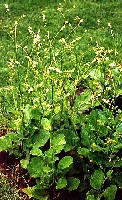View crop
View crop Data sheet EcoPortCrambe abyssinica
 |
|
| Notes |
|---|
| DESCRIPTION: Erect, annual branched cruciferous herb, up to 1-2 m tall depending on season and plant density, branching mostly in the upper half; leaves large, ovate in outline, pinnately lobed, progressively smaller upward; inflorescence a long panicled raceme, the lateral branches of which are sharply ascending and shorter than the primiary axis. The penetrating tap root can reach depths of over 15 cm enabling the plant to be relatively drought resistant later in the season. Flowering indeterminate; flowers small, whitish (typically the flowering period is about 3 weeks); pods numerous, spherical, one-seeded capsules of about 5mm diameter each containing a single spherical seed greenish-brown in colour and 0.8-2.6 mm diameter, indehiscent; seed interior yellow. First-formed pods usually remain on stalk until last-formed pods mature. One plant may produce 530-1,840 fruits. USES: Crambe appears to be a better potential domestic crop than rapeseed. It is the cheapest source of erucic acid, which performs better than any known material as a mold lubricant in continuous steel casting. Test plantings in Russia, under a wide variety of ecological conditions, gave oil contents of 25-33% for seed with hulls (dehulled seeds reached 54%). There are reported yields of 169-840 kg/ha in Indiana, 2,000 in Missouri, suggesting oil yields of about 60-600 kg/ha. Hull-free seeds contain about 26% protein. Crambe meal is used as plywood and rubber adhesive, as a source of protein isolates, and as an additive to waxes. Crambe meal, after unpalatable material is removed or made inactive, may be used as supplement for ruminants not to exceed one-third to one-half of the supplement; it is not recommended for pigs and poultry. The meal is also used as an insecticide. It is used in crop rotations for alleviating weed, pest and disease build-up. GROWING PERIOD: Annual, From planting to harvest requires about 100 days, but this may vary considerably. It has been adapted as a spring crop. KILLING TEMP: Seedlings may survive -4 to -6°C for short periods, but at all later stages of growth -1°C may kill the plant. COMMON NAMES: Crambe, Colewort. FURTHER INF.: Crambe is probably a native of western Asia. It can be grown at elevations between sea level and 2000 m or even up to 2500 m in Kenya. Hail can cause severe damage to crambe, though it generally will recover. Seed yields vary widely from 1,125-1,624 kg/ha in Russia and 450-2,522 kg/ha in the United States, with yields highest in weed-free fields. In irrigated fields with additional nitrogen, yields up to 5 MT/ha have been attained. Cost of production is about the same as for barley. The major problems are weed control and seed-shattering. | Sources |
| Plants For A Future Springdale group - Overview of crambe North Dakota State University; Crambe Production Weiss E 1983 pp 463-486 [TEMP, KTMP, RAIN, LIMIT, TEXT, DRA, PH] Roecklein J 1987 pp 340 [USE] Lessman and Anderson, 1981 [USE] Duke J.A. 1983. Handbook of Energy Crops. unpublished. Last update 1996 Duke J.A. 1975 pp 13 [PH, RAIN, TEMP] Cornelius and Simmons, 1969 [USE] |